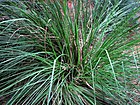Note: This is a project under development. The articles on this wiki are just being initiated and broadly incomplete. You can Help creating new pages.
Chrysopogon zizanioides - Vetiver
Vetiver is a perennial bunchgrass of the Poaceae family, native to India. In western and northern India, it is popularly known as khus.Vetiver is most closely related to Sorghum but shares many morphological characteristics with other fragrant grasses, such as lemongrass, citronella, and palmarosa.
Contents
- 1 Uses
- 2 Parts Used
- 3 Chemical Composition
- 4 Common names
- 5 Properties
- 6 Habit
- 7 Identification
- 8 List of Ayurvedic medicine in which the herb is used
- 9 Where to get the saplings
- 10 Mode of Propagation
- 11 How to plant/cultivate
- 12 Commonly seen growing in areas
- 13 Photo Gallery
- 14 References
- 15 External Links
Uses
Nerve and circulation problems, stress, emotional traumas, lice, repelling insects, insomnia, muscle pain, joint pain, Sore throats
Parts Used
Chemical Composition
Benzoic acid, the molecular formula is C6H5COOH, is a colorless crystalline solid and a simple aromatic carboxylic acid[1]
Common names
| Language | Common name |
|---|---|
| Kannada | |
| Hindi | |
| Malayalam | |
| Tamil | |
| Telugu | |
| Marathi | NA |
| Gujarathi | NA |
| Punjabi | NA |
| Kashmiri | NA |
| Sanskrit | |
| English | Agrimony |
Properties
Reference: Dravya - Substance, Rasa - Taste, Guna - Qualities, Veerya - Potency, Vipaka - Post-digesion effect, Karma - Pharmacological activity, Prabhava - Therepeutics.
Dravya
Rasa
Tikta (Bitter), Kashaya (Astringent)
Guna
Laghu (Light), Ruksha (Dry), Tikshna (Sharp)
Veerya
Ushna (Hot)
Vipaka
Katu (Pungent)
Karma
Kapha, Vata
Prabhava
Habit
Identification
Leaf
| Kind | Shape | Feature |
|---|---|---|
| Simple | The thin leaves and stems are erect and rigid |
Flower
| Type | Size | Color and composition | Stamen | More information |
|---|---|---|---|---|
| Unisexual | 2-4cm long | purple | 1 | the plant bears small brown-purple flowers in long spikes |
Fruit
| Type | Size | Mass | Appearance | Seeds | More information |
|---|---|---|---|---|---|
| 7–10 mm | clearly grooved lengthwise, Lowest hooked hairs aligned towards crown | - | - | {{{6}}} |
Other features
List of Ayurvedic medicine in which the herb is used
- Vishatinduka Taila as root juice extract
Where to get the saplings
Mode of Propagation
How to plant/cultivate
Conical ridges, 30-38 cm high and 48 cm apart are made at the summit and the slips planted 23 cm apart on the summit.[3]
Commonly seen growing in areas
Tall grasslands, meadows, Borders of forests and fields.
Photo Gallery
References
External Links
- Ayurvedic Herbs known to be helpful to treat Nerve and circulation problems
- Ayurvedic Herbs known to be helpful to treat stress
- Ayurvedic Herbs known to be helpful to treat emotional traumas
- Ayurvedic Herbs known to be helpful to treat lice
- Ayurvedic Herbs known to be helpful to treat repelling insects
- Ayurvedic Herbs known to be helpful to treat insomnia
- Ayurvedic Herbs known to be helpful to treat muscle pain
- Ayurvedic Herbs known to be helpful to treat joint pain
- Ayurvedic Herbs known to be helpful to treat Sore throats
- Herbs with Leaves used in medicine
- Herbs with common name in English
- Habit - Herb
- Index of Plants which can be propagated by Seeds
- Index of Plants which can be propagated by Cuttings
- Herbs that are commonly seen in the region of Tall grasslands
- Herbs that are commonly seen in the region of meadows
- Herbs that are commonly seen in the region of Borders of forests and fields
- Herbs





